CNA154 Nursing Practice 1: Reflective Case Study on Nursing Practice
VerifiedAdded on 2023/06/04
|5
|1761
|144
Case Study
AI Summary
This case study reflection examines a student nurse's experience during a clinical placement (PEP) involving an 86-year-old dementia patient. Utilizing Driscoll's reflective model, the student analyzes their initial anxiety and discomfort during a shower assessment, highlighting the importance of informed consent, guidance from experienced nurses, and observation of occupational therapists. The reflection identifies areas for improvement, specifically manual handling skills and therapeutic communication, emphasizing the need for further training and research. The student acknowledges the significance of clinical reflection, assertive attitudes, and understanding individual learning styles for effective future practice, referencing relevant literature to support these points and propose strategies for enhanced patient care.
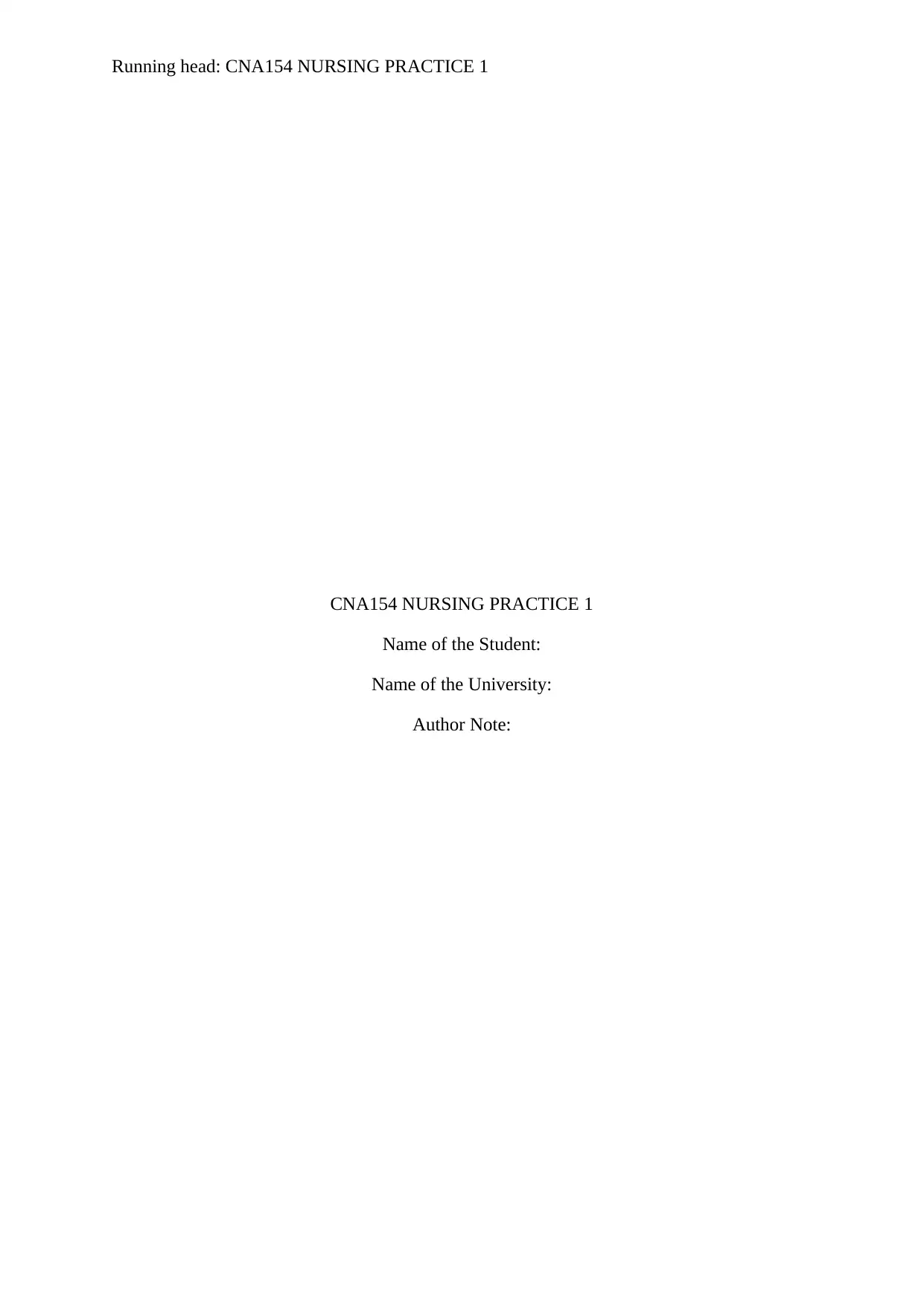
Running head: CNA154 NURSING PRACTICE 1
CNA154 NURSING PRACTICE 1
Name of the Student:
Name of the University:
Author Note:
CNA154 NURSING PRACTICE 1
Name of the Student:
Name of the University:
Author Note:
Paraphrase This Document
Need a fresh take? Get an instant paraphrase of this document with our AI Paraphraser
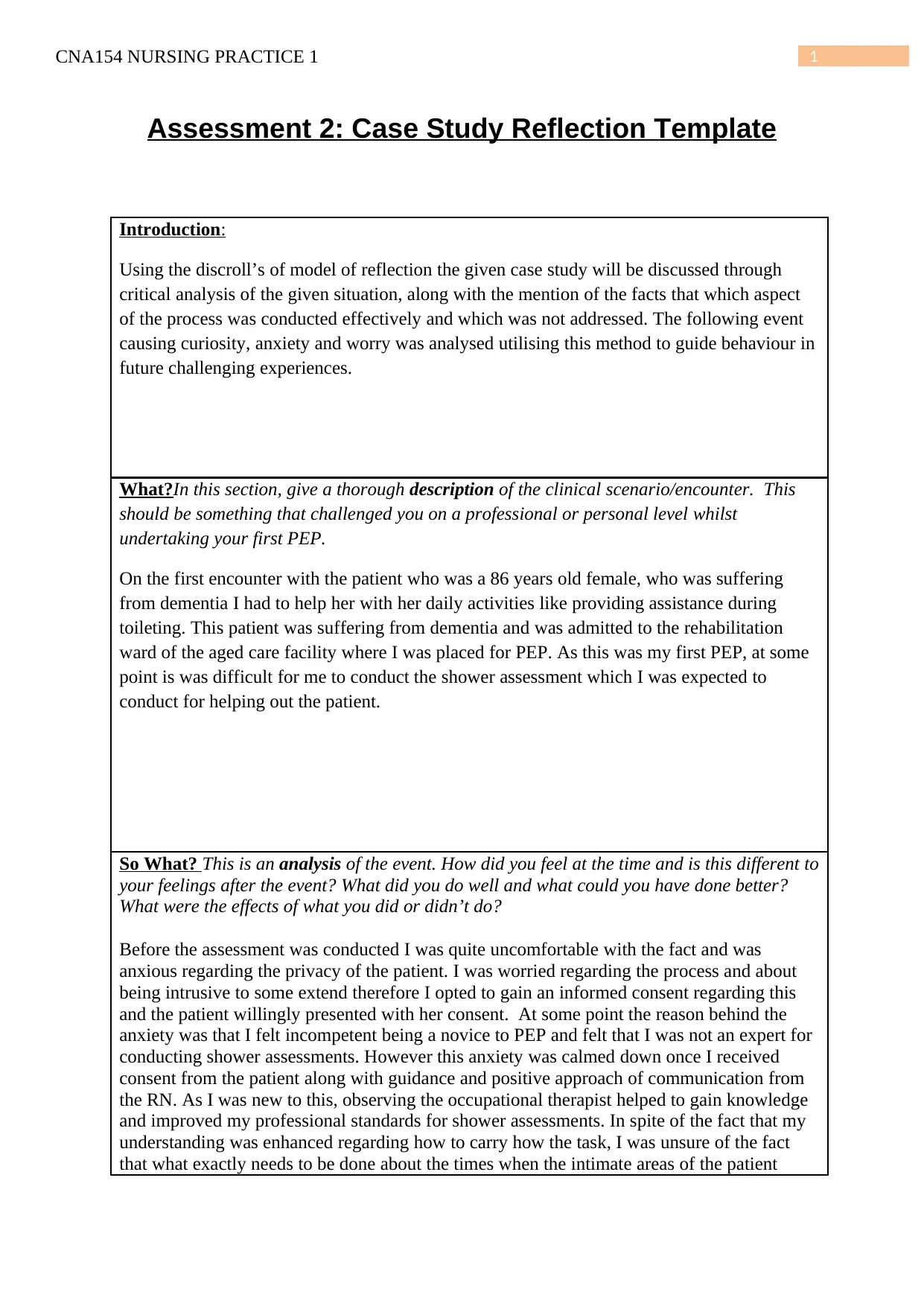
1CNA154 NURSING PRACTICE 1
Assessment 2: Case Study Reflection Template
Introduction:
Using the discroll’s of model of reflection the given case study will be discussed through
critical analysis of the given situation, along with the mention of the facts that which aspect
of the process was conducted effectively and which was not addressed. The following event
causing curiosity, anxiety and worry was analysed utilising this method to guide behaviour in
future challenging experiences.
What?In this section, give a thorough description of the clinical scenario/encounter. This
should be something that challenged you on a professional or personal level whilst
undertaking your first PEP.
On the first encounter with the patient who was a 86 years old female, who was suffering
from dementia I had to help her with her daily activities like providing assistance during
toileting. This patient was suffering from dementia and was admitted to the rehabilitation
ward of the aged care facility where I was placed for PEP. As this was my first PEP, at some
point is was difficult for me to conduct the shower assessment which I was expected to
conduct for helping out the patient.
So What? This is an analysis of the event. How did you feel at the time and is this different to
your feelings after the event? What did you do well and what could you have done better?
What were the effects of what you did or didn’t do?
Before the assessment was conducted I was quite uncomfortable with the fact and was
anxious regarding the privacy of the patient. I was worried regarding the process and about
being intrusive to some extend therefore I opted to gain an informed consent regarding this
and the patient willingly presented with her consent. At some point the reason behind the
anxiety was that I felt incompetent being a novice to PEP and felt that I was not an expert for
conducting shower assessments. However this anxiety was calmed down once I received
consent from the patient along with guidance and positive approach of communication from
the RN. As I was new to this, observing the occupational therapist helped to gain knowledge
and improved my professional standards for shower assessments. In spite of the fact that my
understanding was enhanced regarding how to carry how the task, I was unsure of the fact
that what exactly needs to be done about the times when the intimate areas of the patient
Assessment 2: Case Study Reflection Template
Introduction:
Using the discroll’s of model of reflection the given case study will be discussed through
critical analysis of the given situation, along with the mention of the facts that which aspect
of the process was conducted effectively and which was not addressed. The following event
causing curiosity, anxiety and worry was analysed utilising this method to guide behaviour in
future challenging experiences.
What?In this section, give a thorough description of the clinical scenario/encounter. This
should be something that challenged you on a professional or personal level whilst
undertaking your first PEP.
On the first encounter with the patient who was a 86 years old female, who was suffering
from dementia I had to help her with her daily activities like providing assistance during
toileting. This patient was suffering from dementia and was admitted to the rehabilitation
ward of the aged care facility where I was placed for PEP. As this was my first PEP, at some
point is was difficult for me to conduct the shower assessment which I was expected to
conduct for helping out the patient.
So What? This is an analysis of the event. How did you feel at the time and is this different to
your feelings after the event? What did you do well and what could you have done better?
What were the effects of what you did or didn’t do?
Before the assessment was conducted I was quite uncomfortable with the fact and was
anxious regarding the privacy of the patient. I was worried regarding the process and about
being intrusive to some extend therefore I opted to gain an informed consent regarding this
and the patient willingly presented with her consent. At some point the reason behind the
anxiety was that I felt incompetent being a novice to PEP and felt that I was not an expert for
conducting shower assessments. However this anxiety was calmed down once I received
consent from the patient along with guidance and positive approach of communication from
the RN. As I was new to this, observing the occupational therapist helped to gain knowledge
and improved my professional standards for shower assessments. In spite of the fact that my
understanding was enhanced regarding how to carry how the task, I was unsure of the fact
that what exactly needs to be done about the times when the intimate areas of the patient
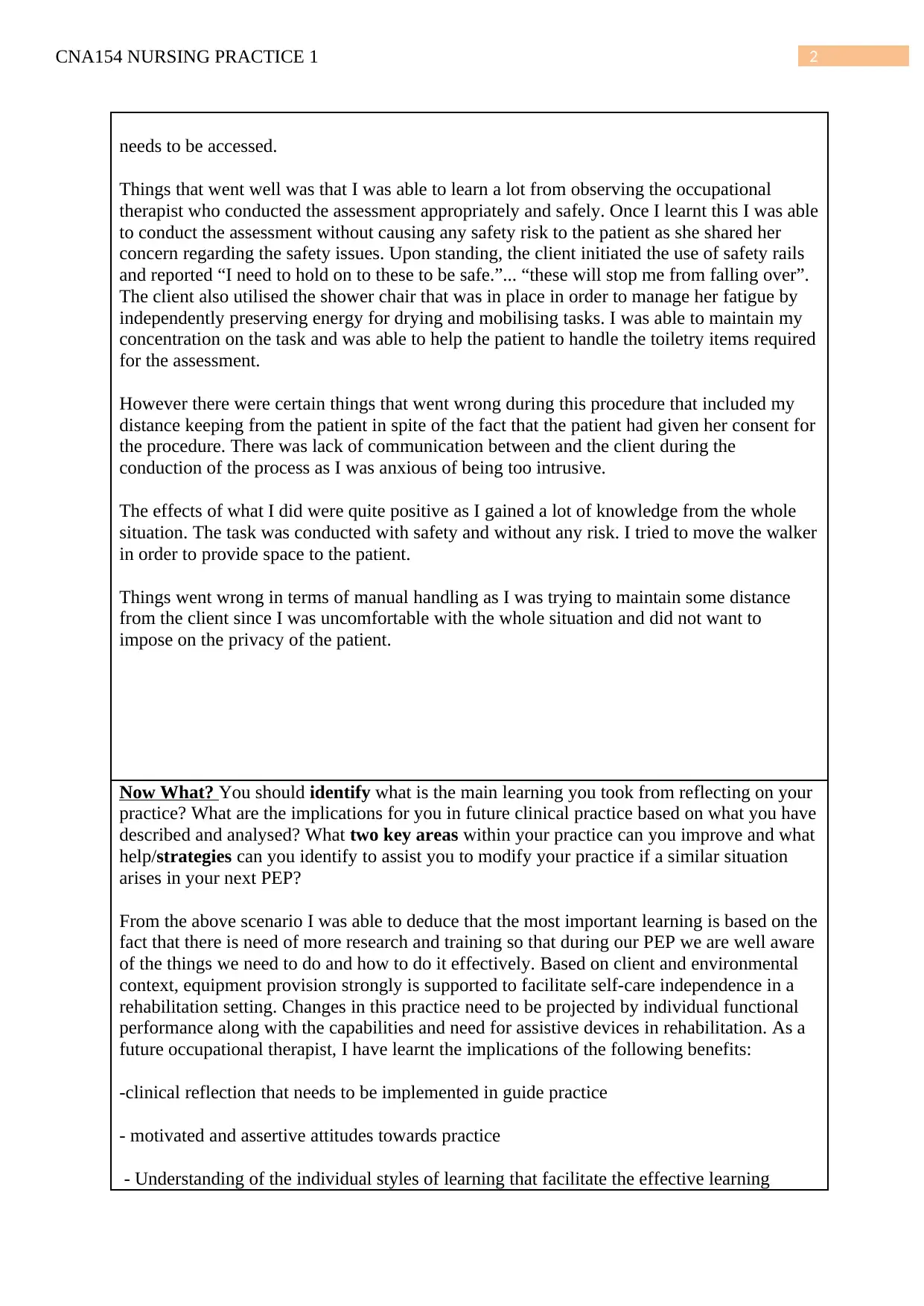
2CNA154 NURSING PRACTICE 1
needs to be accessed.
Things that went well was that I was able to learn a lot from observing the occupational
therapist who conducted the assessment appropriately and safely. Once I learnt this I was able
to conduct the assessment without causing any safety risk to the patient as she shared her
concern regarding the safety issues. Upon standing, the client initiated the use of safety rails
and reported “I need to hold on to these to be safe.”... “these will stop me from falling over”.
The client also utilised the shower chair that was in place in order to manage her fatigue by
independently preserving energy for drying and mobilising tasks. I was able to maintain my
concentration on the task and was able to help the patient to handle the toiletry items required
for the assessment.
However there were certain things that went wrong during this procedure that included my
distance keeping from the patient in spite of the fact that the patient had given her consent for
the procedure. There was lack of communication between and the client during the
conduction of the process as I was anxious of being too intrusive.
The effects of what I did were quite positive as I gained a lot of knowledge from the whole
situation. The task was conducted with safety and without any risk. I tried to move the walker
in order to provide space to the patient.
Things went wrong in terms of manual handling as I was trying to maintain some distance
from the client since I was uncomfortable with the whole situation and did not want to
impose on the privacy of the patient.
Now What? You should identify what is the main learning you took from reflecting on your
practice? What are the implications for you in future clinical practice based on what you have
described and analysed? What two key areas within your practice can you improve and what
help/strategies can you identify to assist you to modify your practice if a similar situation
arises in your next PEP?
From the above scenario I was able to deduce that the most important learning is based on the
fact that there is need of more research and training so that during our PEP we are well aware
of the things we need to do and how to do it effectively. Based on client and environmental
context, equipment provision strongly is supported to facilitate self-care independence in a
rehabilitation setting. Changes in this practice need to be projected by individual functional
performance along with the capabilities and need for assistive devices in rehabilitation. As a
future occupational therapist, I have learnt the implications of the following benefits:
-clinical reflection that needs to be implemented in guide practice
- motivated and assertive attitudes towards practice
- Understanding of the individual styles of learning that facilitate the effective learning
needs to be accessed.
Things that went well was that I was able to learn a lot from observing the occupational
therapist who conducted the assessment appropriately and safely. Once I learnt this I was able
to conduct the assessment without causing any safety risk to the patient as she shared her
concern regarding the safety issues. Upon standing, the client initiated the use of safety rails
and reported “I need to hold on to these to be safe.”... “these will stop me from falling over”.
The client also utilised the shower chair that was in place in order to manage her fatigue by
independently preserving energy for drying and mobilising tasks. I was able to maintain my
concentration on the task and was able to help the patient to handle the toiletry items required
for the assessment.
However there were certain things that went wrong during this procedure that included my
distance keeping from the patient in spite of the fact that the patient had given her consent for
the procedure. There was lack of communication between and the client during the
conduction of the process as I was anxious of being too intrusive.
The effects of what I did were quite positive as I gained a lot of knowledge from the whole
situation. The task was conducted with safety and without any risk. I tried to move the walker
in order to provide space to the patient.
Things went wrong in terms of manual handling as I was trying to maintain some distance
from the client since I was uncomfortable with the whole situation and did not want to
impose on the privacy of the patient.
Now What? You should identify what is the main learning you took from reflecting on your
practice? What are the implications for you in future clinical practice based on what you have
described and analysed? What two key areas within your practice can you improve and what
help/strategies can you identify to assist you to modify your practice if a similar situation
arises in your next PEP?
From the above scenario I was able to deduce that the most important learning is based on the
fact that there is need of more research and training so that during our PEP we are well aware
of the things we need to do and how to do it effectively. Based on client and environmental
context, equipment provision strongly is supported to facilitate self-care independence in a
rehabilitation setting. Changes in this practice need to be projected by individual functional
performance along with the capabilities and need for assistive devices in rehabilitation. As a
future occupational therapist, I have learnt the implications of the following benefits:
-clinical reflection that needs to be implemented in guide practice
- motivated and assertive attitudes towards practice
- Understanding of the individual styles of learning that facilitate the effective learning
⊘ This is a preview!⊘
Do you want full access?
Subscribe today to unlock all pages.

Trusted by 1+ million students worldwide
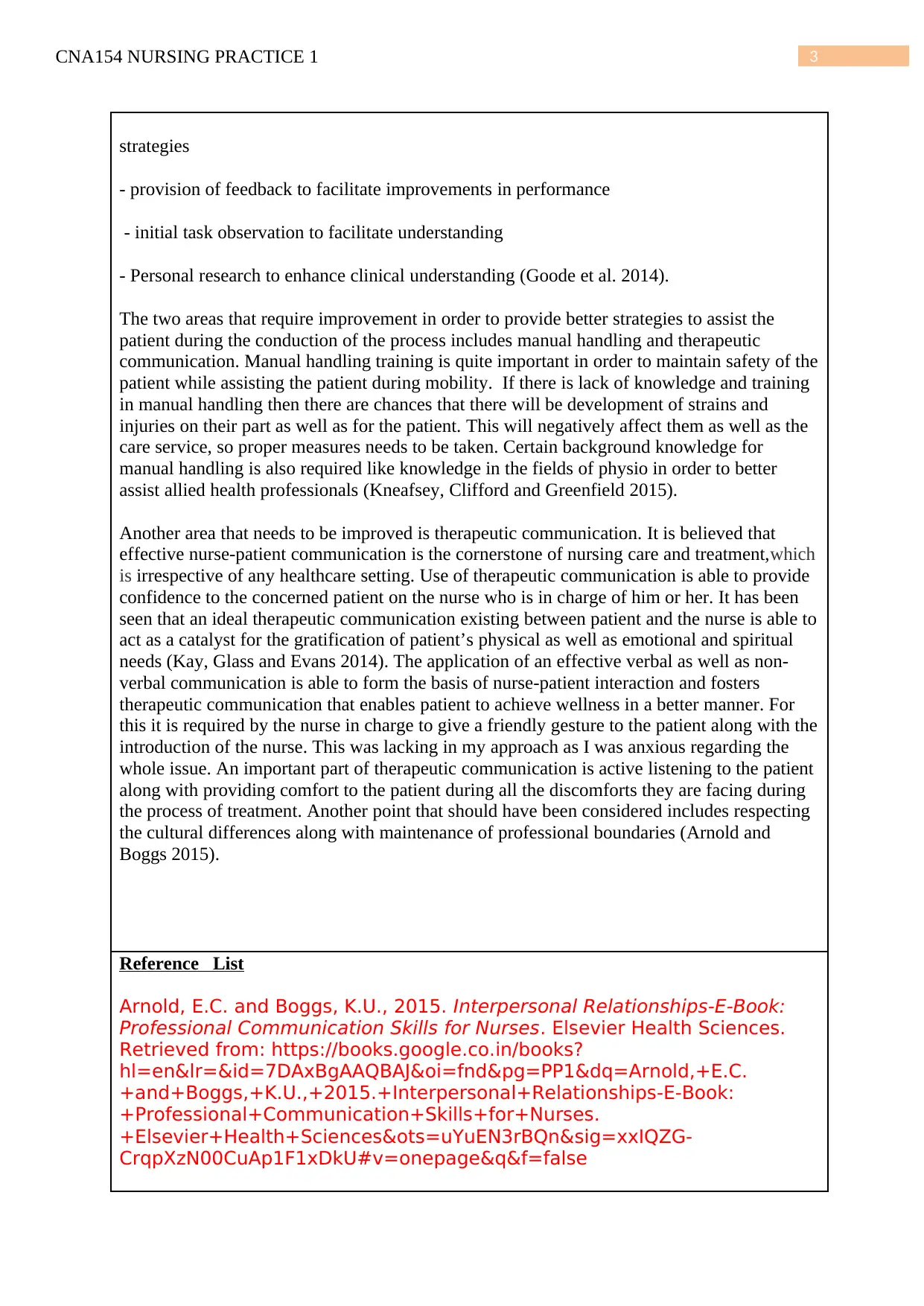
3CNA154 NURSING PRACTICE 1
strategies
- provision of feedback to facilitate improvements in performance
- initial task observation to facilitate understanding
- Personal research to enhance clinical understanding (Goode et al. 2014).
The two areas that require improvement in order to provide better strategies to assist the
patient during the conduction of the process includes manual handling and therapeutic
communication. Manual handling training is quite important in order to maintain safety of the
patient while assisting the patient during mobility. If there is lack of knowledge and training
in manual handling then there are chances that there will be development of strains and
injuries on their part as well as for the patient. This will negatively affect them as well as the
care service, so proper measures needs to be taken. Certain background knowledge for
manual handling is also required like knowledge in the fields of physio in order to better
assist allied health professionals (Kneafsey, Clifford and Greenfield 2015).
Another area that needs to be improved is therapeutic communication. It is believed that
effective nurse-patient communication is the cornerstone of nursing care and treatment,which
is irrespective of any healthcare setting. Use of therapeutic communication is able to provide
confidence to the concerned patient on the nurse who is in charge of him or her. It has been
seen that an ideal therapeutic communication existing between patient and the nurse is able to
act as a catalyst for the gratification of patient’s physical as well as emotional and spiritual
needs (Kay, Glass and Evans 2014). The application of an effective verbal as well as non-
verbal communication is able to form the basis of nurse-patient interaction and fosters
therapeutic communication that enables patient to achieve wellness in a better manner. For
this it is required by the nurse in charge to give a friendly gesture to the patient along with the
introduction of the nurse. This was lacking in my approach as I was anxious regarding the
whole issue. An important part of therapeutic communication is active listening to the patient
along with providing comfort to the patient during all the discomforts they are facing during
the process of treatment. Another point that should have been considered includes respecting
the cultural differences along with maintenance of professional boundaries (Arnold and
Boggs 2015).
Reference List
Arnold, E.C. and Boggs, K.U., 2015. Interpersonal Relationships-E-Book:
Professional Communication Skills for Nurses. Elsevier Health Sciences.
Retrieved from: https://books.google.co.in/books?
hl=en&lr=&id=7DAxBgAAQBAJ&oi=fnd&pg=PP1&dq=Arnold,+E.C.
+and+Boggs,+K.U.,+2015.+Interpersonal+Relationships-E-Book:
+Professional+Communication+Skills+for+Nurses.
+Elsevier+Health+Sciences&ots=uYuEN3rBQn&sig=xxIQZG-
CrqpXzN00CuAp1F1xDkU#v=onepage&q&f=false
strategies
- provision of feedback to facilitate improvements in performance
- initial task observation to facilitate understanding
- Personal research to enhance clinical understanding (Goode et al. 2014).
The two areas that require improvement in order to provide better strategies to assist the
patient during the conduction of the process includes manual handling and therapeutic
communication. Manual handling training is quite important in order to maintain safety of the
patient while assisting the patient during mobility. If there is lack of knowledge and training
in manual handling then there are chances that there will be development of strains and
injuries on their part as well as for the patient. This will negatively affect them as well as the
care service, so proper measures needs to be taken. Certain background knowledge for
manual handling is also required like knowledge in the fields of physio in order to better
assist allied health professionals (Kneafsey, Clifford and Greenfield 2015).
Another area that needs to be improved is therapeutic communication. It is believed that
effective nurse-patient communication is the cornerstone of nursing care and treatment,which
is irrespective of any healthcare setting. Use of therapeutic communication is able to provide
confidence to the concerned patient on the nurse who is in charge of him or her. It has been
seen that an ideal therapeutic communication existing between patient and the nurse is able to
act as a catalyst for the gratification of patient’s physical as well as emotional and spiritual
needs (Kay, Glass and Evans 2014). The application of an effective verbal as well as non-
verbal communication is able to form the basis of nurse-patient interaction and fosters
therapeutic communication that enables patient to achieve wellness in a better manner. For
this it is required by the nurse in charge to give a friendly gesture to the patient along with the
introduction of the nurse. This was lacking in my approach as I was anxious regarding the
whole issue. An important part of therapeutic communication is active listening to the patient
along with providing comfort to the patient during all the discomforts they are facing during
the process of treatment. Another point that should have been considered includes respecting
the cultural differences along with maintenance of professional boundaries (Arnold and
Boggs 2015).
Reference List
Arnold, E.C. and Boggs, K.U., 2015. Interpersonal Relationships-E-Book:
Professional Communication Skills for Nurses. Elsevier Health Sciences.
Retrieved from: https://books.google.co.in/books?
hl=en&lr=&id=7DAxBgAAQBAJ&oi=fnd&pg=PP1&dq=Arnold,+E.C.
+and+Boggs,+K.U.,+2015.+Interpersonal+Relationships-E-Book:
+Professional+Communication+Skills+for+Nurses.
+Elsevier+Health+Sciences&ots=uYuEN3rBQn&sig=xxIQZG-
CrqpXzN00CuAp1F1xDkU#v=onepage&q&f=false
Paraphrase This Document
Need a fresh take? Get an instant paraphrase of this document with our AI Paraphraser
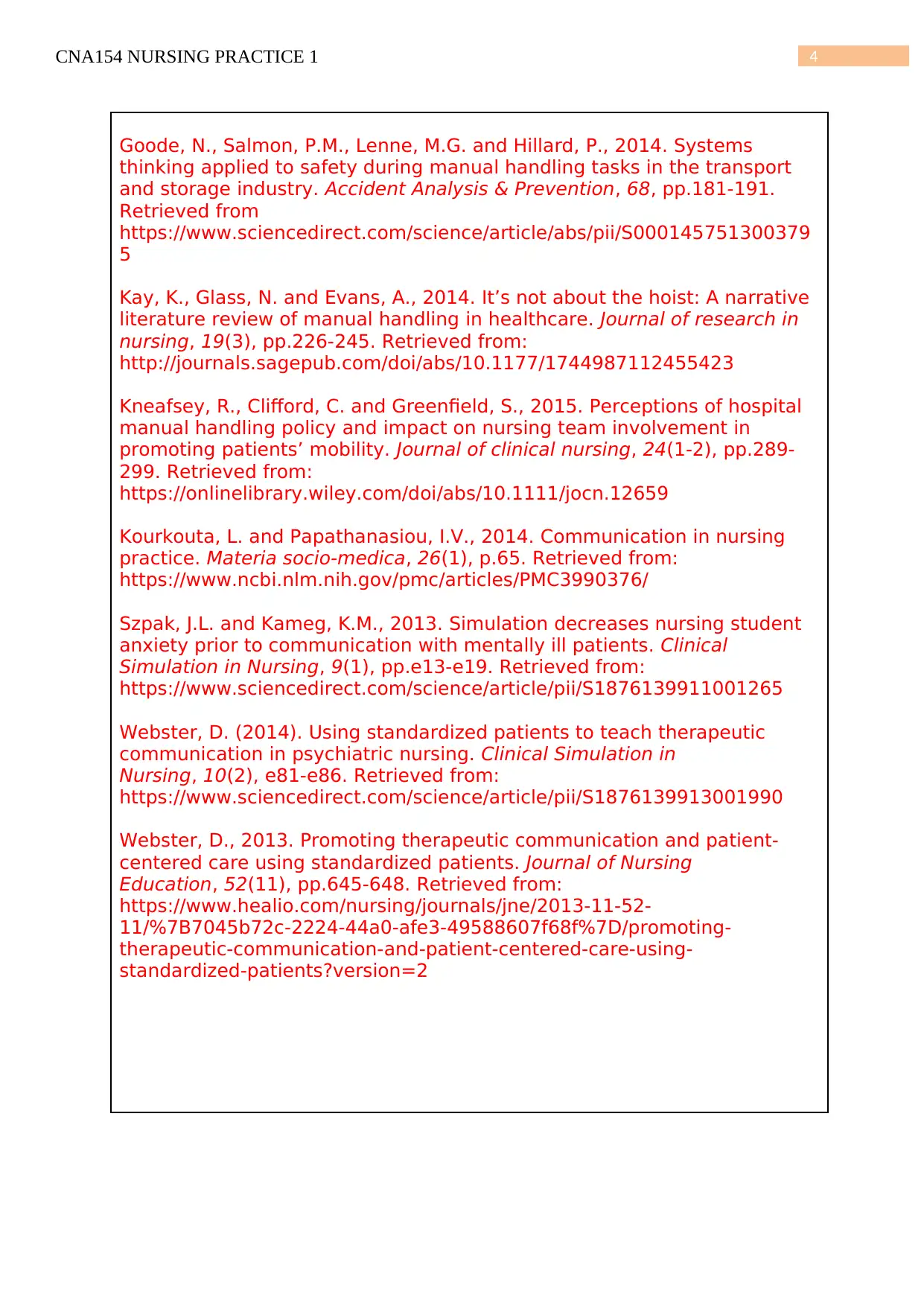
4CNA154 NURSING PRACTICE 1
Goode, N., Salmon, P.M., Lenne, M.G. and Hillard, P., 2014. Systems
thinking applied to safety during manual handling tasks in the transport
and storage industry. Accident Analysis & Prevention, 68, pp.181-191.
Retrieved from
https://www.sciencedirect.com/science/article/abs/pii/S000145751300379
5
Kay, K., Glass, N. and Evans, A., 2014. It’s not about the hoist: A narrative
literature review of manual handling in healthcare. Journal of research in
nursing, 19(3), pp.226-245. Retrieved from:
http://journals.sagepub.com/doi/abs/10.1177/1744987112455423
Kneafsey, R., Clifford, C. and Greenfield, S., 2015. Perceptions of hospital
manual handling policy and impact on nursing team involvement in
promoting patients’ mobility. Journal of clinical nursing, 24(1-2), pp.289-
299. Retrieved from:
https://onlinelibrary.wiley.com/doi/abs/10.1111/jocn.12659
Kourkouta, L. and Papathanasiou, I.V., 2014. Communication in nursing
practice. Materia socio-medica, 26(1), p.65. Retrieved from:
https://www.ncbi.nlm.nih.gov/pmc/articles/PMC3990376/
Szpak, J.L. and Kameg, K.M., 2013. Simulation decreases nursing student
anxiety prior to communication with mentally ill patients. Clinical
Simulation in Nursing, 9(1), pp.e13-e19. Retrieved from:
https://www.sciencedirect.com/science/article/pii/S1876139911001265
Webster, D. (2014). Using standardized patients to teach therapeutic
communication in psychiatric nursing. Clinical Simulation in
Nursing, 10(2), e81-e86. Retrieved from:
https://www.sciencedirect.com/science/article/pii/S1876139913001990
Webster, D., 2013. Promoting therapeutic communication and patient-
centered care using standardized patients. Journal of Nursing
Education, 52(11), pp.645-648. Retrieved from:
https://www.healio.com/nursing/journals/jne/2013-11-52-
11/%7B7045b72c-2224-44a0-afe3-49588607f68f%7D/promoting-
therapeutic-communication-and-patient-centered-care-using-
standardized-patients?version=2
Goode, N., Salmon, P.M., Lenne, M.G. and Hillard, P., 2014. Systems
thinking applied to safety during manual handling tasks in the transport
and storage industry. Accident Analysis & Prevention, 68, pp.181-191.
Retrieved from
https://www.sciencedirect.com/science/article/abs/pii/S000145751300379
5
Kay, K., Glass, N. and Evans, A., 2014. It’s not about the hoist: A narrative
literature review of manual handling in healthcare. Journal of research in
nursing, 19(3), pp.226-245. Retrieved from:
http://journals.sagepub.com/doi/abs/10.1177/1744987112455423
Kneafsey, R., Clifford, C. and Greenfield, S., 2015. Perceptions of hospital
manual handling policy and impact on nursing team involvement in
promoting patients’ mobility. Journal of clinical nursing, 24(1-2), pp.289-
299. Retrieved from:
https://onlinelibrary.wiley.com/doi/abs/10.1111/jocn.12659
Kourkouta, L. and Papathanasiou, I.V., 2014. Communication in nursing
practice. Materia socio-medica, 26(1), p.65. Retrieved from:
https://www.ncbi.nlm.nih.gov/pmc/articles/PMC3990376/
Szpak, J.L. and Kameg, K.M., 2013. Simulation decreases nursing student
anxiety prior to communication with mentally ill patients. Clinical
Simulation in Nursing, 9(1), pp.e13-e19. Retrieved from:
https://www.sciencedirect.com/science/article/pii/S1876139911001265
Webster, D. (2014). Using standardized patients to teach therapeutic
communication in psychiatric nursing. Clinical Simulation in
Nursing, 10(2), e81-e86. Retrieved from:
https://www.sciencedirect.com/science/article/pii/S1876139913001990
Webster, D., 2013. Promoting therapeutic communication and patient-
centered care using standardized patients. Journal of Nursing
Education, 52(11), pp.645-648. Retrieved from:
https://www.healio.com/nursing/journals/jne/2013-11-52-
11/%7B7045b72c-2224-44a0-afe3-49588607f68f%7D/promoting-
therapeutic-communication-and-patient-centered-care-using-
standardized-patients?version=2
1 out of 5
Related Documents
Your All-in-One AI-Powered Toolkit for Academic Success.
+13062052269
info@desklib.com
Available 24*7 on WhatsApp / Email
![[object Object]](/_next/static/media/star-bottom.7253800d.svg)
Unlock your academic potential
Copyright © 2020–2025 A2Z Services. All Rights Reserved. Developed and managed by ZUCOL.





